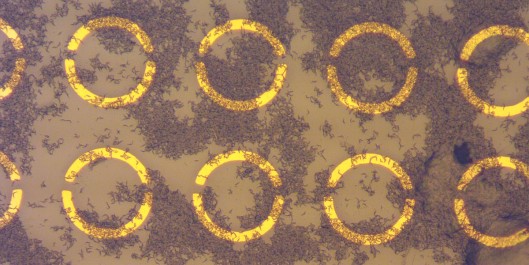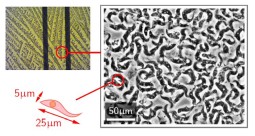Elektromagnetische mm- und THz-Sensoren zur Detektion der Afrikanischen Trypanosomiasis mit Hilfe von RNA-Aptameren derivatisierten Oberflächen
Phase 1 und 2
In dem vorliegenden Projekt untersuchen wir die Entwicklung von elektromagnetischen (EM) Sensoren zur Detektion von Afrikanischen Trypanosomen. Dies sind parasitäre Organismen, die die afrikanische Schlafkrankheit auslösen. Unbehandelt führt die Schlafkrankheit zum Tode, so dass die zeitlich frühe Detektion von Parasiten im Blut von infizierten Patienten essentiell ist.
Projektleitung:
Prof. Dr.-Ing. Christian Damm, Institut für Mikrowellentechnik, Universität Ulm
Prof. Dr. H. Ulrich Göringer, Molecular Genetics, Technische Universität Darmstadt
Dr. Daniel Neumaier, AMO GmbH Aachen
Forschungsgruppe:
Dr. Robert Knieß, Molecular Genetics, TU Darmstadt
Dr. Ulrich Plachetka, AMO GmbH Aachen
Dr. Bartos Chmielak, Aachen
Simon Sawalich, Aachen
Mario Müh, Institut für Mikrowellentechnik und Photonik, TU Darmstadt
Ziele
Overall aim: The aim of this project is the development of sensor structures based on the combination of electromagnetic (EM) sensors and biological functional layers for the detection of pathogenic agents. For this purpose, different types of electromagnetic sensor structures in the range of mm- and THz-waves will be studied. Since the functional layers are very thin (monolayers in the nanometer range) compared to the electromagnetic wavelength (3mm – 100µm), structures with very high sensitivity are required. To enable sufficient interaction between EM-fields and biolayers, a strong subwavelength field confinement has to be applied.
The types include resonant as well as non-resonant structures with different waveguiding principles, mostly based on periodic structures and metamaterials. For the functionalization of these sensors, nucleic acid (NA)-aptamer layers will be studied. The goal of the project is to evaluate the sensitivity of different EM-sensor approaches and the detection limit of the pathogen. Different possibilities to increase the sensitivity by increased interaction between electromagnetic fields and functional layers and the exploitation of frequency-specific spectral features of the considered functional layers will be used to reach the lowest possible detection limit.
As a first step, a thorough electromagnetic characterization of possible functional layer types and possible substrates compatible with the EM-structure as well as the biological functionalization is necessary. With that knowledge, appropriate sensor structures can be designed. Passivation or seed layers for the immobilization of the aptamers on top of the structure have to be evaluated in terms of their electromagnetic, biochemical and technical processing properties to guarantee strong bonding of the functional layer and low influence on the electromagnetic readout at the same time.
The previous work on the THz-detection of surface-bound biomolecules has been mainly limited to DNA molecules. The planned project will extend the research to RNA-aptamers because of their high biomedical relevance and the expected presence of conformation-specific absorption bands in the low THz-range. This step is not trivial since RNA-molecules require surrounding water molecules for the stabilization of their molecular structure. Thick layers of water (>100µm) are however critical in terms of THz-absorption. The project will hence start with the investigation of molecules which can be measured in dried conditions and then proceed to biomolecular layers covered by a liquid layer.
Surface-bound NA-monolayers have the advantage of high molecular stability even in the case of a dried surface. This stability is very helpful for the fabrication and handling of biochips, which are based on an array of sensor spots with characteristic probe molecules (e.g. aptamers) bound to each of the sensor spot surfaces. Without loss of the bio-functionality of the surface-bound RNA-molecules it is possible to carry out measurements in dry conditions where measurements at THz-frequencies can be conducted without being hindered by the absorption of a fluid surrounding. However, one disadvantage of surface-bound NA-monolayers is that specific THz-absorption bands could not be measured on such layers so far. Reasons for this situation might be given by the extremely low thickness of the monolayer and the application of relatively small molecules such as oligonucleotides with a length of only 25 nucleotides (t < 10nm). The frequency of the lowest order collective vibrational modes might hence still be above the spectroscopical accessible range or the interaction length might be too short to generate a measurable contrast. Therefore, an important objective of this project will be to increase the interaction of the THz-excitation field with the aptamer films by using field concentrating nano-gap structures embedded in planar metallic THz-resonators. The THz-resonance is governed by the micron-scale dimensions of the resonator. Increased local field enhancement is achieved by the implementation of nano-scale gap structures into the planar resonators.
By localizing the aptamer probes at the positions of local field enhancement it is intended to amplify the sensitivity to the biomolecular collective vibrational modes to such a level, which allows the selective sampling of specific absorption bands. This approach shall not only allow the increase of the sensitivity but also the selectivity of the THz-based detection of biomolecules due to the narrow-band frequency selective sampling of aptamer-specific resonances on the biochip. In order to explore the physical and technical limits of the sensitivity of the THz biochip approach a further objective of this project is to implement a near-field read-out head for the direct sampling of singular resonators of an array in contrast to the conventional collective read-out of multiple coupled resonators by a diffraction limited THz-beam. The new approach should enable a sensitivity increase by approx. more than a factor of 25 due to the reduction of required sample material and the direct sampling of enhanced field amplitudes in the near-field of each resonator in contrast to scattered far-field amplitudes which are expected to be more than two orders of magnitude lower.
The lack of suitable diagnostic tools in developing countries is a major stumbling block for disease control. This holds especially true for African trypanosomiasis. Simple, accurate and reliable diagnostic tests are essentially missing for both forms (chronic/acute) of the disease. As a consequence, the scientific and technological objective of the proposal is the design of an EM-based detection device for the diagnosis of African trypanosomiasis in livestock and human blood samples. For that we will make use of a panel of chemically modified RNA-aptamers specific for different surface proteins of the parasite, which can capture the pathogen with high specificity and high affinity. The proposal includes all necessary steps to demonstrate “proof-of-principle” of the EM-aptasensor approach and is intended to provide the groundwork for the design of a prototype-device for a fast, robust and low cost detection of African sleeping sickness.
Abstract
Wir schlagen die Entwicklung von elektromagnetischen (EM) Sensoren zur Detektion von Afrikanischen Trypanosomen vor. Dies sind parasitäre Organismen, die die afrikanische Schlafkrankheit auslösen. Unbehandelt führt die Schlafkrankheit zum Tode, so dass die zeitlich frühe Detektion von Parasiten im Blut von infizierten Patienten essentiell ist.
Die EM-Sensoren sollen im mm- und THz-Frequenzbereich arbeiten. Sie werden mit einer Schicht chemisch resistenter, trypanosomen-spezifischer RNA-Aptamere funktionalisiert. Aptamere sind synthetische, biomolekulare Affinitätsreagenzien, die die Fähigkeit haben die Oberfläche der Parasitenzellen mit hoher Spezifität und hoher Affinität zu binden. Die aus der Aptamer/Trypanosonen-Bindung resultierenden geringen dielektrischen Änderungen sollen als Messsignal detektiert werden. Zusätzlich planen wir, die auf inhärenten Molekülresonanzen beruhenden spektralen Absoptionscharakteristika von Aptameren zur Sensitivitätssteigerung bei der Detektion zu nutzen.
Zwei unterschiedliche Sensorstrukturen sollen entwickelt und analysiert werden. Beide Strukturen basieren auf Subwellenlängen-Resonatoren und Metamaterialien mit lokal stark überhöhten Feldern und Resonanzen mit sehr hohem Gütefaktor Q für die Interaktion mit der Aptamerschicht. Der nanostrukturierte Sensor soll über Nahfeldsonden ausgelesen werden. Sie werden für diesen Zweck speziell entwickelt. Der mikrostrukturierte Sensor wird mit kommerziellen mm- und THz-Messgeräten ausgewertet.
Die Aptamere werden sowohl enzymatisch als auch chemisch synthetisiert. Es sollen unterschiedliche chemische Kopplungsstrategien mit den zur Immobilisierung notwendigen Trägermaterialien getestet werden. Faktoren wie die Aptamerdichte auf der Oberfläche und unterschiedliche Trägermaterial-Geometrien wie z.B. poröse, dreidimensionale Glass- und Polystyrenkügelchen werden in Bezug auf ihren Einfluß auf das EM-Signal analysiert. Eine Optimierung der Aptamerschichten soll durch die Synthese von dimeren bzw. trimeren Aptamer-Arrangements erfolgen, da erhöhte Schichtstärken einfacher messbare EM-Signale bedingen.
Die Motivation für das Projekt ist multifaktoriell. Die Abwesenheit von brauchbaren diagnostischen Verfahren und Geräten in Entwicklungsländern ist ein zentraler Faktor bei der Kontrolle von Krankheiten. Dies gilt insbesondere für die afrikanische Schlafkrankheit. Einfache und verlässliche Tests sind derzeit nicht vorhanden. Die vorgeschlagenen Sensoren sollten es möglich machen billige, flexibel einsatzfähige und robuste point-of-care Geräte herzustellen.
Der gewählte Frequenzbereich ist hier besonders interessant, da die Eindringtiefe grösser ist als in der Optik und opake Materialien kein Hindernis darstellen. Zusätzlich zeigen hier viele biologische Moleküle spezifische spektrale Eigenschaften. Aptamere lassen sich für nahezu jedweden Liganden generieren, was die Universalität der von uns vorgeschlagenen Vorgehensweise unterschreicht.
Publikationen
Maasch, M.; Mueh, M. & Damm, C. Sensor Array on Structured PET Substrates for Detection of Thin Dielectric Layers at Terahertz Frequencies 2017 IEEE MTT-S International Microwave Symposium (IMS), 2017
BestStudentPaper Award: Mueh, M.; Maasch, M.; Brecht, M.; Göringer, H. U. & Damm, C. Complex Dielectric Characterization of African Trypanosomes for Aptamer-based Terahertz Sensing Applications Proceedings of IMBIOC 2017, 2017




